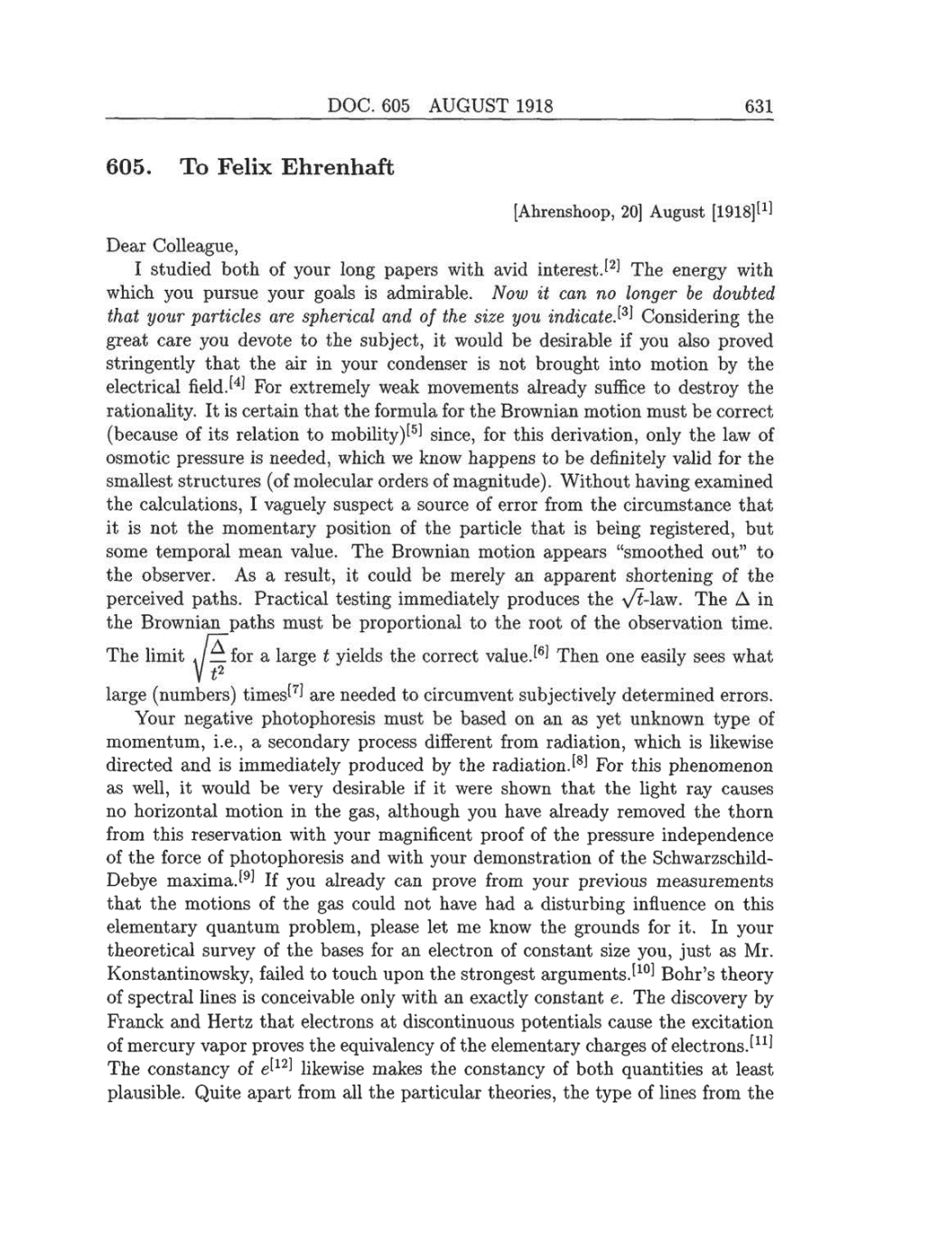DOC.
605
AUGUST
1918 631
605. To
Felix Ehrenhaft
[Ahrenshoop,
20]
August
[1918][1]
Dear
Colleague,
I
studied both
of
your long papers
with
avid interest.[2] The
energy
with
which
you pursue your goals
is
admirable.
Now
it
can no
longer be
doubted
that
your particles
are
spherical
and
of
the size
you indicate.[3]
Considering
the
great
care you
devote to
the
subject,
it
would be desirable if
you
also
proved
stringently
that the
air in
your
condenser
is not
brought
into motion
by
the
electrical
field.[4]
For
extremely
weak movements
already
suffice
to
destroy
the
rationality.
It
is
certain that the
formula for
the
Brownian motion must be correct
(because
of its
relation
to
mobility)[5]
since,
for this
derivation, only
the
law of
osmotic
pressure is needed,
which
we
know
happens
to
be
definitely
valid for
the
smallest structures
(of
molecular orders
of
magnitude).
Without
having
examined
the
calculations,
I
vaguely suspect
a
source
of
error
from
the
circumstance
that
it
is
not
the
momentary
position
of
the
particle
that
is
being registered,
but
some
temporal
mean
value. The Brownian
motion
appears
“smoothed out” to
the
observer. As
a result,
it
could be
merely an
apparent
shortening
of
the
perceived
paths.
Practical
testing
immediately produces
the
-t-law. The
A in
the
Brownian
paths
must be
proportional
to
the
root
of
the
observation time.
The limit
A/t2
for
a large
t
yields
the correct
value.[6]
Then
one
easily
sees
what
large (numbers)
times[7]
are
needed to circumvent
subjectively
determined
errors.
Your
negative
photophoresis
must be based
on an as yet
unknown
type of
momentum, i.e.,
a
secondary process
different from
radiation,
which
is
likewise
directed
and
is
immediately produced by
the
radiation.[8] For this
phenomenon
as well,
it would be
very
desirable
if
it
were
shown
that the
light ray causes
no
horizontal
motion in
the
gas, although you
have
already
removed
the thorn
from this reservation with
your
magnificent
proof
of
the
pressure independence
of
the
force of
photophoresis
and with
your
demonstration of
the
Schwarzschild-
Debye
maxima.[9]
If
you already
can
prove
from
your previous
measurements
that the
motions of
the
gas
could not have had
a
disturbing
influence
on
this
elementary
quantum
problem, please
let
me
know
the
grounds
for it. In
your
theoretical
survey
of
the
bases
for
an
electron
of
constant
size
you,
just
as
Mr.
Konstantinowsky,
failed to touch
upon
the
strongest
arguments.[10]
Bohr’s
theory
of
spectral
lines
is
conceivable
only
with
an
exactly
constant
e.
The
discovery by
Franck and Hertz
that
electrons at discontinuous
potentials
cause
the excitation
of
mercury vapor proves
the
equivalency
of
the
elementary charges
of
electrons.[11]
The
constancy
of
e[12]
likewise makes
the
constancy
of
both
quantities
at least
plausible. Quite
apart
from all
the
particular theories,
the
type
of lines
from
the
